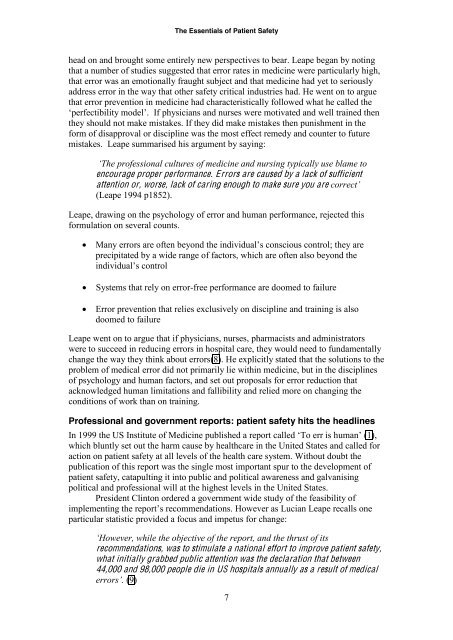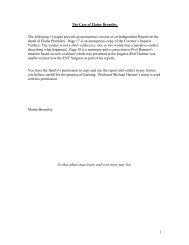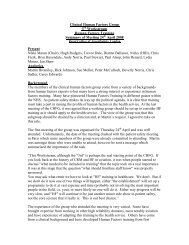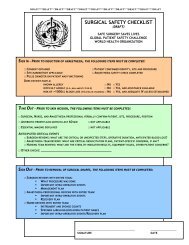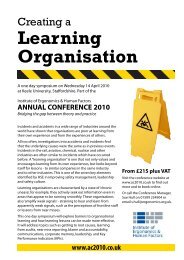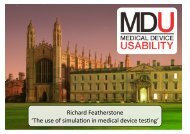The Essentials of Patient Safety - Clinical Human Factors Group
The Essentials of Patient Safety - Clinical Human Factors Group
The Essentials of Patient Safety - Clinical Human Factors Group
Create successful ePaper yourself
Turn your PDF publications into a flip-book with our unique Google optimized e-Paper software.
<strong>The</strong> <strong>Essentials</strong> <strong>of</strong> <strong>Patient</strong> <strong>Safety</strong><br />
head on and brought some entirely new perspectives to bear. Leape began by noting<br />
that a number <strong>of</strong> studies suggested that error rates in medicine were particularly high,<br />
that error was an emotionally fraught subject and that medicine had yet to seriously<br />
address error in the way that other safety critical industries had. He went on to argue<br />
that error prevention in medicine had characteristically followed what he called the<br />
<br />
they should not make mistakes. If they did make mistakes then punishment in the<br />
form <strong>of</strong> disapproval or discipline was the most effect remedy and counter to future<br />
mistakes. Leape summarised his argument by saying:<br />
<br />
encourage proper performance. Errors are caused by a lack <strong>of</strong> sufficient<br />
attention or, worse, lack <strong>of</strong> caring enough to make sure you are <br />
(Leape 1994 p1852).<br />
Leape, drawing on the psychology <strong>of</strong> error and human performance, rejected this<br />
formulation on several counts.<br />
<br />
precipitated by a wide range <strong>of</strong> factors, which are <strong>of</strong>ten also beyond the<br />
<br />
<br />
Systems that rely on error-free performance are doomed to failure<br />
Error prevention that relies exclusively on discipline and training is also<br />
doomed to failure<br />
Leape went on to argue that if physicians, nurses, pharmacists and administrators<br />
were to succeed in reducing errors in hospital care, they would need to fundamentally<br />
change the way they think about errors(8). He explicitly stated that the solutions to the<br />
problem <strong>of</strong> medical error did not primarily lie within medicine, but in the disciplines<br />
<strong>of</strong> psychology and human factors, and set out proposals for error reduction that<br />
acknowledged human limitations and fallibility and relied more on changing the<br />
conditions <strong>of</strong> work than on training.<br />
Pr<strong>of</strong>essional and government reports: patient safety hits the headlines<br />
(1),<br />
which bluntly set out the harm cause by healthcare in the United States and called for<br />
action on patient safety at all levels <strong>of</strong> the health care system. Without doubt the<br />
publication <strong>of</strong> this report was the single most important spur to the development <strong>of</strong><br />
patient safety, catapulting it into public and political awareness and galvanising<br />
political and pr<strong>of</strong>essional will at the highest levels in the United States.<br />
President Clinton ordered a government wide study <strong>of</strong> the feasibility <strong>of</strong><br />
However as Lucian Leape recalls one<br />
particular statistic provided a focus and impetus for change:<br />
<br />
recommendations, was to stimulate a national effort to improve patient safety,<br />
what initially grabbed public attention was the declaration that between<br />
44,000 and 98,000 people die in US hospitals annually as a result <strong>of</strong> medical<br />
(9)<br />
7


